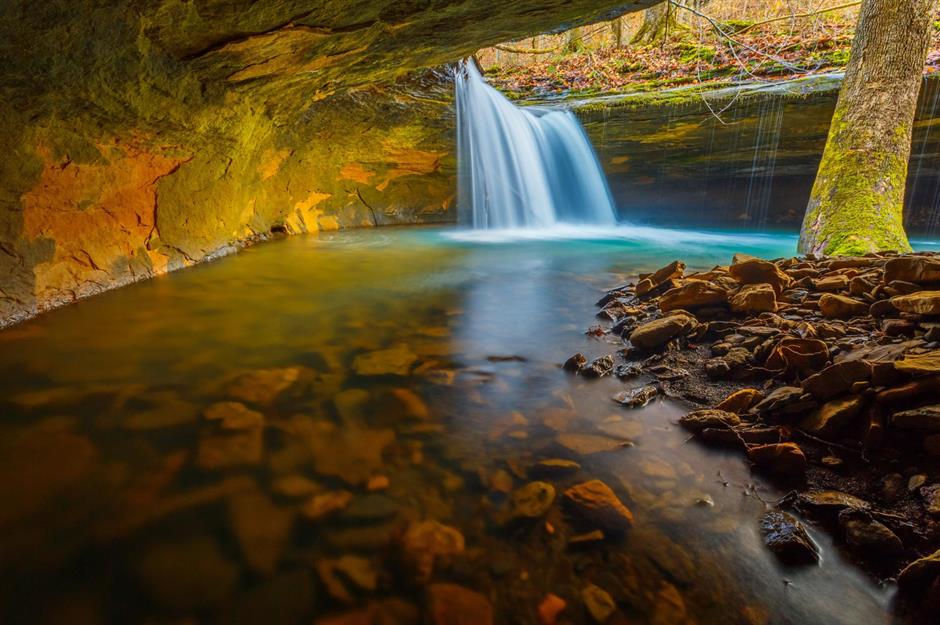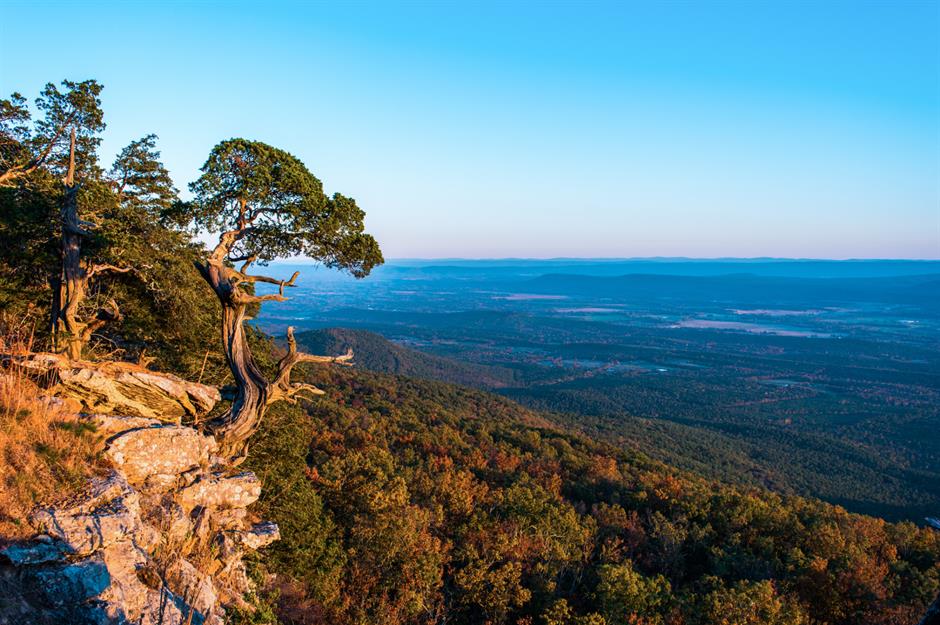Secrets of the Ozarks revealed
Welcome to the Ozarks
With Netflix's hit show Ozark reaching its fourth and final season, many viewers might be wondering what the series' setting has to offer in real life. Most don’t know much about this relatively remote part of the United States, that's filled with natural wonders, opportunities for recreation and relaxation and a few quirks along the way too. Here are a few facts to help you to better get to know this beautiful part of the country.
What exactly are the Ozarks?
The Ozarks aren’t centred around a specific city or nature reserve – the name actually refers to a large mountain range in the south-central United States. The mountains span portions of five states: Missouri, Arkansas, Illinois, Oklahoma and Kansas, with the largest portion in Missouri, although the actual boundaries are vague. All in all, the range occupies about 50,000 square miles (130,000 sq km).
Its name is French
Unlike many oddly named places in the US, the name Ozark isn’t a reference to an early colonialist’s surname, although its roots are in colonialism. It’s believed to be a misspelling of the words Aux Arc, which was a French trading post in the area in the 1700s. The phase translates to 'with bows', likely a reference to the Quapaw people, who were also known as the Bow Indians. Either way, there’s still a campground on the Lake of the Ozarks that bears the Aux Arc name.
Found in the middle of the plains
There aren’t a lot of mountains in the middle part of the United States – those 'flyover' states are shockingly flat. The Ozark Mountains (paired with the adjacent Ouachita Mountains) are the only rough ‘n’ rugged range between the Appalachians and the Rocky Mountains. If you take a look at a topographical map (or literally fly across the country), you’ll see that there’s a lot of smooth plains in between those ranges.
Soar to high heights
While the Ozarks might not get the same fanfare as the majestic Appalachians or the incredibly tall Rockies, the range does have some pretty impressive peaks. Many of the mountains in the Boston section of the Ozark range (which are actually all in Arkansas and nowhere near Boston) are more than 2,000-feet (600m) high and the famed Taum Sauk Mountain in Missouri is a mighty 1,772 feet (540m).
Love this? Follow our Facebook page for more travel inspiration
Larger than life lake
The Ozarks region is as famous for the Lake of the Ozarks as it is for the mountains that the area is named after, largely because of the sheer size of that particular body of water. With its various arms and nooks and crannies, the lake has 1,100 miles (1,770km) of coastline, which is more than the state of California. It’s no wonder it’s such a popular spot for boating and watersports, with so many places to dock and so much water to explore.
It's actually a fake lake
Surprisingly, the Lake of the Ozarks is not a natural body of water – technically speaking, it’s a man-made lake. The massive lake is the result of the impounding of the Osage River to create a hydroelectric power system. The lake was first flooded in 1931 and the operation didn’t just create power, but a major tourist destination for boaters and lakeside vacationers.
Discover more beautiful lakes you won't believe are man-made
Bagnell Dam
Bagnell Dam, the largest and last major dam in the United States to be financed through private investment, is the reason the Lake of the Ozarks exists. The spectacular feat of engineering harnesses the Osage River and is a half-mile (0.8km) long, holding back 600 billion gallons of water. It’s a producer of energy, creating enough power to supply 42,000 households throughout the year.
The Magic Dragon
Since the Lake of the Ozarks is a flooding of the Osage River, it twists and turns as a river would, giving it a snake-like appearance. That serpentine shape has earned it the nickname 'the Magic Dragon'. It’s a common enough moniker that some events and businesses situated around the lake use the nickname in their company names. There’s even an annual car show called the Magic Dragon Street Meet.
Plenty more fish in the... lake
The lakes and rivers of the Ozarks are rich with fish, particularly several species of bass and catfish, as well as trout, crappie and carp, all of which attract many recreational fishing boats. There are also more unexpected water creatures like small freshwater jellyfish, which are not believed to be native to North America but do periodically appear in the Lake of the Ozarks, particularly in late summer and early autumn.
Porsche in the water
Fish aren’t the only thing that have been known to be found in the vast waters of the Lake of the Ozarks. In 2002 a Porsche Sportster convertible was found submerged in the lake and after being pulled out, the car was confirmed to have been recently stolen from a transport truck. The twist to the story is that the sports car, a collector’s item worth $100,000 (£72,590), belonged to Hollywood actor Nicolas Cage.
Premium shorefront properties
The shoreline along the Lake of the Ozarks is privately owned, which means there are a lot of homes that sit almost directly on the water, enjoying premium boat access and magnificent views. There are somewhere in the neighbourhood of 70,000 private homes lining the shores of the lake, many of which are vacation homes that are only occupied during lake season in the summer months.
Ha Ha Tonka State Park
Filled with forests, sinkholes, dramatic bluffs and beautiful views of the Lake of the Ozarks’ Niangua Arm, Ha Ha Tonka State Park is a jewel of the Missouri section of the Ozarks. The park’s most famous feature is the site of a 1905 European-style stone castle which is now in a state of romantic ruin. The park is also a popular spot for hiking and fishing, as well as anyone who just wants to drink in the beauty of the ruins and surrounding nature.
Miles of mills
With all of the water flowing around the Ozarks, it’s not surprising that there a number of historic mills scattered around the region. Mills like the Rockbridge Mill (built in 1865 after the original structure burnt down in the Civil War), the picturesque Alley Mill and the bright red Hodgson Mill are all favourites of photographers and Instagrammers. Most of the mills are no longer in operation, but many welcome visitors and some offer tours.
Ozark National Forest
Those looking for rough and ready wilderness will find it in the Ozark National Forest, a 1.2 million-acre area in northern Arkansas. This is real Ozark backcountry – the rugged terrain is home to countless hiking trails, oak and hickory hardwood forests, wild rivers and ample wildlife. 'Primitive' camping is allowed in much of the wilderness area for a truly outdoor experience.
The Cave State
With over 6,400 caves, Missouri is known by many as the Cave State and many of those caves and caverns exist within the Ozarks. The Ozark Caverns in Lake of the Ozark State Park and the caves at Meramec State Park are some of the most famous, thanks to their unique rock formations and the cave tours offered to visitors.
Karst landforms are also hidden underground
The Ozark region is home to a complex karst ecosystem consisting of sinkholes, caves and underground springs that are an important home to at least 60 different varieties of organisms including bats, fish, spiders and salamanders, many of which are protected species. The karst system is also responsible for many of the area’s pristine streams and ground water supply.
Folk culture
Folk archivist Max Hunter immortalised the glory of mid-century Ozark life though 1,600 recordings made between 1956 and 1976. A travelling salesman by trade, Hunter would take a tape recorder out to mountainous regions and capture stories and songs from locals in Arkansas and Missouri. Hunter’s collection is now available online through a partnership with the Missouri State University of Music and the Springfield-Greene County Library.
Ozark dialect
Much like other parts of the rural United States, the Ozarks have a history of people speaking in a distinct dialect. It’s similar to the English spoken in the Appalachians and flourished in the late 1800s because of the relative isolation of the area. The original Ozark dialect is said to be heavily influenced by Elizabethan English, but the speech patterns have long been diluted as people from the area have mixed with visitors and travelled themselves.
Immortalised in literature
While the area has always been beautiful, the masses didn’t truly discover the Ozarks as a place to visit until the publication of Harold Bell Wright’s 1907 novel The Shepherd of the Hills, which was a huge national bestseller. The book's depiction of the region’s awe-inspiring natural wonder helped establish the city of Branson, Missouri as a top tourist destination.
Cities in the Ozarks
The Ozarks aren’t all about natural beauty, there are also plenty of towns and cities to explore. Branson, Missouri, known for its huge collection of theatres and entertainment district, is probably the most famous, but other cities like Springfield, Missouri and Osage Beach (where the TV show Ozark is set) are also prominent commercial centres in the region.
Ozarkland
A trip to the Ozarks requires a little bit of kitsch, which can be found at the Ozarkland chain of stores, which sell everything from candy and souvenirs to Christmas ornaments and fireworks. With locations in Kingdom City, Branson, Camdenton and a few other places, it’s a tourist trap, but also a decent place to stock up in the midst of an Ozarks road trip.
Glorious golf courses
Fishing, boating and hiking are all commonplace sports in the Ozarks, but golf is also extremely popular with visitors to the area, thanks to the beautiful views surrounding each course. There’s even a Lake of the Ozarks 'golf trail', featuring 13 different golf courses. One of the Ozarks' most famous course is the Payne’s Valley Golf Course, the first public-access course designed by the one and only Tiger Woods.
Art and coffee
The Ozarks are known for being a fairly down-home rural place, but it does have chic urban elements. The Arkansas city of Bentonville is home to the impressive Crystal Bridges Museum of American Art and its satellite venue The Momentary, which hosts music and other artistic performances. There's also a couple of bars and the renowned Onyx Coffee Lab coffee shop.
Red Oak II
Naturally, the Ozarks have a healthy dose of American weirdness scattered about the area, including the large-scale art installation known as Red Oak II. This 'town' near Carthage, Missouri is a recreation of artist Lowell Davis’ now dissolved hometown, complete with faux versions of the town gas station, diner, school and a few houses. There’s even a Red Oak II festival to bring together fans of this Missouri oddity.
Check out the world's most jaw-dropping statues and sculptures
Thorncrown Chapel
Architect E. Fay Jones designed a series of glass chapels that are hidden in the forests of Arkansas, including this beauty near Eureka Springs, which first opened in 1980. With 425 windows, the little church blends in with its natural surroundings, giving visitors a spiritual experience, no matter what their religious affiliation may be. Sunday services are held from April through to October.
Discover the world's most beautiful sacred and spiritual sites

